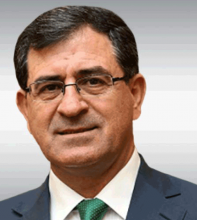You are here
Is there a need for a new inflation target
Apr 09,2024 - Last updated at Apr 09,2024
The statements of Federal Reserve Governor Michelle Bowman sparked wide reactions in the financial markets and economic policymaking circles last Friday as she hinted at the possibility of raising interest rates to address the phenomenon of inflation, while warning of a future slowdown in progress in this area. Bowman indicated that rapid reductions in interest rates may increase inflation, necessitating larger interest increases in the future. This statement comes in light of increasing tension over the course of interest policy amid a rise in consumer prices and an improvement in the level of inflation.
Bowman’s strategy is based on a balance between the need for caution and the need to provide effective measures to reduce inflation. By emphasising that increases in interest rates may be necessary, Bowman reflects a conservative view that may lead to greater economic stability in the long run.
Despite Bowman’s warnings, there remains a difference of opinion within the Fed regarding the future path of interest rates. Some, including Fed Chairman Jerome Powell, indicated that there is no urgent need to cut interest rates currently, which raised questions about the Fed’s strategy in dealing with the challenges of inflation and the economy.
It is important to note that the Fed’s movements have a significant impact on the financial markets and the global economy, and therefore understanding their trends is crucial for investors and traders in the financial markets.
It seems that inflation and the issue of determining the interest rate path will remain the focus of attention of markets and analysts in the coming months, and what the US Federal Reserve decides will have a major impact on global economic expectations.
Fed members’ orientations regarding interest policy may differ, as some focus on the urgent need to stimulate the economy by reducing interest rates, while others focus on achieving a balance between stimulating economic growth and combating inflation. Will we witness a division within the Open Market Committee at its next meeting, after the Fed’s decisions to raise interest rates since March 2022, and its decisions to stabilise interest rates in the last five meetings, were unanimous?
The Fed’s decisions on interest policy have impacts on the global economy, as a rise or fall in interest rates affects the level of investment, inflation and the exchange rate of other countries. The statements indicate the need for the Fed to have a clear strategy in dealing with the current economic challenges, so that they have an effective plan to reduce inflation without weakening economic growth. Therefore, managing inflation and interest policy requires careful guidance and a wise strategy from the Fed, with a balance between stimulating economic growth and controlling inflation to ensure macroeconomic stability.
Another important question that arises is: “Is there a need to set a new target for the inflation rate closer to 3 per cent instead of 2 per cent, to reflect a trend towards enhancing economic stimulus and achieving greater growth?”
To answer this question, we say: In light of the current economic challenges, monetary policy developments, and the prolonged period of monetary tightening that lasted for twenty-five months, there is an urgent need to re-evaluate the inflation target in the United States. It is expected that the trend towards updating this target to 3 per cent instead of the US Federal Reserve’s traditional target of 2 per cent will enhance financial and economic stability in general, and open the door to a more effective and flexible monetary policy. Among the most prominent justifications for updating the inflation target, we mention the following:
First, enhancing economic growth: The new inflation target can contribute to stimulating economic growth by enhancing consumer demand. When consumers expect prices to rise in the future, they may spend more now to avoid cost increases later, which in turn drives economic growth.
Second, improving the effectiveness of monetary policy: The move towards a new inflation target enhances flexibility in the Fed’s policy and provides them with greater scope to respond more quickly to changing economic challenges. When the inflation target is at 3 per cent, the Fed has more flexibility to reduce or raise interest rates in proportion to actual economic conditions.
Third, avoiding fiscal denial: The economy may suffer from the risk of fiscal denial, ignoring or downplaying accumulated debt or unsustainably large financial obligations when the inflation rate is very low. If inflation is below target, this can slow economic growth and increase the risk of economic recession.
Fourth, reducing employment costs: Updating the inflation target can reduce employment costs, as the slight inflation reflected by the 3 per cent target encourages greater salary increases, which helps relieve pressure on workers and increase the purchasing power of the individual.
Fifth, ensuring price stability: Although the inflation target has been raised to 3 per cent, the target remains under control and within the framework of financial stability, which ensures that inflation does not worsen excessively and maintains price stability in the long term. The definition of financial stability becomes achieving an inflation rate at 3 per cent, not 2 per cent.
We conclude by saying that updating the inflation target to 3 per cent represents an important step to enhance economic growth and improve the effectiveness of monetary policy, while at the same time maintaining price stability and reducing the risk of financial denial. In Jordan, we would benefit greatly from this modernisation if it were to begin because inflation rates have been under control for many months and there is an urgent need to stimulate economic growth that has been slow for a long time and create job opportunities in various sectors of the economy.














Add new comment